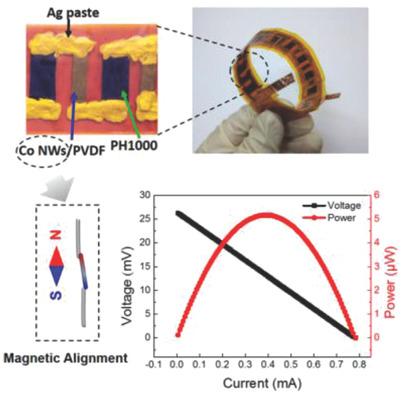当前位置:
X-MOL 学术
›
Adv. Electron. Mater.
›
论文详情
Our official English website, www.x-mol.net, welcomes your feedback! (Note: you will need to create a separate account there.)
Flexible Thermoelectric Generators with Ultrahigh Output Power Enabled by Magnetic Field–Aligned Metallic Nanowires
Advanced Electronic Materials ( IF 6.2 ) Pub Date : 2018-07-16 , DOI: 10.1002/aelm.201800200 Yani Chen 1 , Minhong He 1 , Junhui Tang 1 , Guillermo C. Bazan 2 , Ziqi Liang 1
Advanced Electronic Materials ( IF 6.2 ) Pub Date : 2018-07-16 , DOI: 10.1002/aelm.201800200 Yani Chen 1 , Minhong He 1 , Junhui Tang 1 , Guillermo C. Bazan 2 , Ziqi Liang 1
Affiliation

|
Emerging organic–inorganic thermoelectric nanocomposites (TENCs) are promising candidates for the realization of high‐performance flexible thermoelectric generators (TEGs), yet there is an absence of effective means to precisely regulate the film morphology of TENCs. Here, the use of a magnetic field to improve thermoelectric performance of solution fabricated n‐type metallic TENCs is reported. Of particular relevance is that the magnetic field gives rise to aligned Co nanowires (NWs) within a poly(vinylidene fluoride) (PVDF) matrix. Such oriented TENCs exhibit significantly increased electrical conductivity in comparison to identical nanocomposites that are randomly oriented. As a result, the best power factor of oriented Co NWs (80 wt%)/PVDF TENCs reaches 523 µW m−1 K−2 at 320 K, which is among the highest reported n‐type TENCs. By pairing these n‐type TENCs with benchmark p‐type poly(3,4‐ethylenedioxythiophene)‐poly(styrenesulfonate) (PEDOT:PSS) thin films, the fabrication of flexible and planar TEGs that yield a maximum output voltage and power of 26.4 mV and 5.2 µW when ∆T = 50 K, respectively, is reported.
中文翻译:

磁场对准的金属纳米线可实现具有超高输出功率的柔性热电发电机
新兴的有机-无机热电纳米复合材料(TENC)是实现高性能柔性热电发生器(TEG)的有前途的候选者,但尚缺乏有效的手段来精确调节TENC的薄膜形态。在这里,据报道使用磁场来改善溶液制造的n型金属TENC的热电性能。特别相关的是,磁场会在聚偏二氟乙烯(PVDF)基质内产生排列的Co纳米线(NWs)。与随机取向的相同纳米复合材料相比,这种取向的TENC显示出显着提高的电导率。结果,定向Co NW(80 wt%)/ PVDF TENC的最佳功率因数达到523 µW m -1 K -2在320 K时,这是报告的n型TENC最高的之一。通过将这些n型TENC与基准p型聚(3,4-亚乙基二氧噻吩)-聚(苯乙烯磺酸盐)(PEDOT:PSS)薄膜配对,可制造出柔性且平面的TEG,其最大输出电压和功率为26.4当ΔT = 50 K时,分别报告mV和5.2 µW 。
更新日期:2018-07-16
中文翻译:

磁场对准的金属纳米线可实现具有超高输出功率的柔性热电发电机
新兴的有机-无机热电纳米复合材料(TENC)是实现高性能柔性热电发生器(TEG)的有前途的候选者,但尚缺乏有效的手段来精确调节TENC的薄膜形态。在这里,据报道使用磁场来改善溶液制造的n型金属TENC的热电性能。特别相关的是,磁场会在聚偏二氟乙烯(PVDF)基质内产生排列的Co纳米线(NWs)。与随机取向的相同纳米复合材料相比,这种取向的TENC显示出显着提高的电导率。结果,定向Co NW(80 wt%)/ PVDF TENC的最佳功率因数达到523 µW m -1 K -2在320 K时,这是报告的n型TENC最高的之一。通过将这些n型TENC与基准p型聚(3,4-亚乙基二氧噻吩)-聚(苯乙烯磺酸盐)(PEDOT:PSS)薄膜配对,可制造出柔性且平面的TEG,其最大输出电压和功率为26.4当ΔT = 50 K时,分别报告mV和5.2 µW 。



























 京公网安备 11010802027423号
京公网安备 11010802027423号